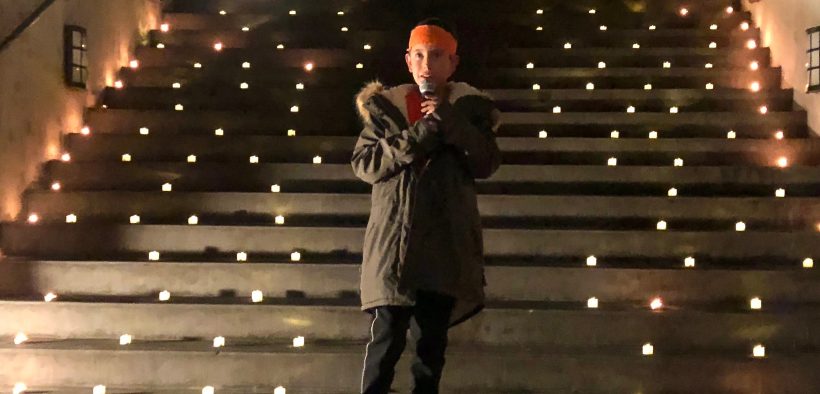There Sure Are a Lot of “Lone” Wolves Out There


Dylann Roof, who killed nine people in a Charleston, SC church in 2015, though considered a “lone wolf” attacker, is one of a growing number of people dining on hateful beliefs promulgated in online circles. (Photo Credit: Charleston County Sheriff’s Office)
A bar or nightclub. An office building. A place of worship. A school. Seemingly weekly, news of horrific acts of violence by a “lone wolf” attacker reaches our consciousness. Just recently, a shooting at the Chabad of Poway Synagogue in southern California, which left one person dead and three injured, made headlines.
The profile is all too familiar: a sole gunman entered and opened fire with an assault weapon. That the shooting occurred on Passover also suggests this was more than a coincidence; multiple officials, including President Donald Trump, referred to it as a “hate crime.” According to San Diego County sheriff William Gore and as first reported in USA TODAY on April 27, though law enforcement officials were still verifying its authenticity, a “manifesto” of sorts posted online around the time of the attack hinted at the shooter’s possible motivations/reasons for targeting Jews.
In terms of our experience and our feelings about these attacks, it’s difficult to know to what degree we should feel encouraged or dismayed. Concerning the Poway synagogue shooting in particular, that only one person died certainly is worth celebrating. Viewing these matters more globally, however, the verdict is less clear, and with each attack, our ability to process it all is tested.
Undoubtedly, for the communities directly impacted by this sort of violence, the brutality and sense of loss felt is profound. Recent suicides by survivors of the Marjory Stoneman Douglas High School shooting in Parkland, FL and by the father of one of the children lost in the Sandy Hook Elementary attack speak to the devastating long-term emotional toll gun violence can effect. To say the suffering is a shared one appears wholly accurate.
Even for those of us who haven’t felt the brunt of the carnage wrought by lone wolf attackers and other perpetrators of mass violence, the repetition of the same story may be affecting in its own way. Each tragedy can feel like a punch to the gut, or worse, we may become numb to these events as a function of their apparent frequency. As is often talked about in media circles, we then run the risk of allowing these acts of terrorism to become the “new normal.”
A survivor of a 2018 school shooting in Santa Fe, when asked whether she were surprised about what transpired, replied that she felt “eventually [a shooting] was going to happen” at her school. Her resignation to this idea as a young child, sounding more defeated than optimistic, was perhaps the most heartbreaking aspect of this affair. I can only imagine how parents of young children must feel today, sending their children off to school in clear or bulletproof backpacks to participate in active shooter drills. It’s not a set of circumstances I envy.
Witnessing news reports on incidences of hate-fueled violence, as with other crimes, can make them seem more common than they actually are. We respond to the gravity of these situations and not necessarily to the statistical likelihood we will face our own personal encounters with this type of thing. Still, trends in observed data surrounding mass shootings and mass murderers are enough to cause alarm, even though the odds of an attack in our neighborhood may be comparatively slim.
Though published back in 2016, a Frontline PBS report by Katie Worth on the increasing incidence and lethality of lone wolf attacks still carries weight. Citing available research from multiple sources on the subject, Worth explains how five core findings have emerged relating to trends in this kind of violence in the United States. The findings, as she spells them out:
1. Lone wolf attacks are becoming more common. While noting these attacks are still rare and though they are nothing new, Worth details how both the number of attacks and the number of fatalities from these events have gone up in the past decade. In fact, by the date of the Frontline report, the 2010s had already surpassed all other decades in these regards, so one can only imagine where we’re at now.
2. White supremacist ideologies remain the top source of inspiration for lone wolves, though jihadism is also a significant influence. Though the left is not immune to instances of lone wolf attacks, predominantly, it is right-wing extremism which motivates these terrorists. And whether they are white supremacists or jihadis, they are terrorists. Though their exact motivations may be different (the appeal of al-Qaeda and ISIS for some young Westerners is particularly disturbing to national security experts), don’t let the absence of their condemnation and the disproportionate anti-Muslim rhetoric of conservative circles convince you there is some gargantuan divide between them.
3. Lone wolves are different than conventional terrorists. Though terrorists they may be, there are distinctions to be had. Lone wolves are mostly single white males with a criminal record, diverging from those who commit violence as part of a political organization in that they tend to be older, less educated, and significantly more prone to mental illness. Perhaps most surprisingly, lone wolf attackers motivated in part by politics tend to resemble if they aren’t patently indistinguishable from apolitical mass murderers who harbor some personal grievance. The only major difference herein is that mass murderers are more likely to perpetrate violence in a place with which they are familiar, whereas lone wolves are more likely to go somewhere previously unknown.
4. Guns are lone wolves’ weapon of choice. Though once upon a time, lone wolf attacks in America more frequently featured the use of explosives, controls on the purchase of bomb-making materials following the 1995 Oklahoma City bombings are believed to be a key factor in reducing the incidence of attacks involving explosive devices. The bad news is that the permissiveness of U.S. gun laws has afforded would-be lone wolves with a staggering array of high-velocity firearms capable of hurting or killing many people in a short span. Say what you want about the Second Amendment, but the statistics are pretty clear on this front.
5. Lone wolves usually tell others about their plans. Whether it’s a cryptic post on social media, a manifesto mailed to media outlets, or some other sign of intent, lone wolves frequently telegraph their acts of violence. Of course, prevention is no easy task and finding useful intelligence to this effect raises concerns about surveillance and possible infringement of people’s civil liberties. As the report also indicates, lone wolf attacks tend to be less effective and deadly than coordinated attacks involving multiple actors. These notions aside, with this type of threat on the rise, there is some comfort in knowing investigators have hope for stopping the next tragedy in that these threats don’t usually arise in complete isolation.
It bears underscoring that not everyone who holds extremist beliefs goes on to shoot up a church or school or what-have-you. As alluded to earlier, lone wolf attacks, though on the rise, are still fairly uncommon. It should also be noted that not everyone professing fealty to an extremist cause necessarily believes in all its tenets. As experts on the subject will aver, what complicates our understanding of lone wolf attacks is that some individuals get involved with extremist movements simply as a means of inciting violence. The backdrop of hate serves as a backdoor to inflicting pain and suffering.
From a law enforcement/criminal justice standpoint, this may facilitate their prosecution. Whatever the reasons for committing these crimes, they are highly visible. In our ever-present search for meaning, however, the obscurity of a perpetrator’s motive can lead to frustration or downright despair. How do we overcome something when its very form is elusive? To say this isn’t easy seems like the understatement of understatements. In addition, our comprehension of these matters is hindered by a lack of available information on the subject, aided (and abetted) by a shift at the federal level away from viewing all forms of domestic terrorism as such. Under President Trump, counterterrorism efforts have focused almost exclusively on Islamic terrorism.
Meanwhile, the Trump administration has eliminated distinctions between different types of domestic terrorism, conflating white supremacist violence with that of so-called “black identity extremists” in its new category of “racially-motivated violent extremism,” confusing the frequency of cases between the two. This is no accident, a move with political designs written all over them, a concession to Trump’s base and to the changing face of the Republican Party. The president’s supporters by and large do not want to contemplate the rise of white supremacist violence here and abroad. Trump and his administration are only too happy to acquiesce.
This intentional minimization of the threat posed by white supremacists in the U.S. is understandably not lost on the rest of us, especially not members of the opposition party. Earlier this month, a handful of Democratic senators including presidential hopefuls Amy Klobuchar, Cory Booker, and Kamala Harris signed and sent a letter to Attorney General William Barr (yes, that AG Barr) and FBI director Christopher Wray admonishing the Department of Justice and the Bureau for failing to adequately acknowledge and address the growing danger posed by white supremacist terrorism.
The senators also charged the DOJ and FBI with taking concrete steps to address this issue, outlining resources to be used in their efforts, and to explain why its classification system for domestic terrorism changed in the first place. Decry this as an “attack” on Trump designed to garner political capital if you will, but these concerns are undoubtedly shared by these legislators’ constituents and scores of other Americans like you and me. Even political opportunists get it right at least occasionally.
Irrespective of examples of mass shootings and other violence, the exigency of curbing white supremacist influence around the world demands action. Since Trump’s inauguration, outward shows of racism, xenophobia, and other forms of prejudice have become more mainstream. On one hand, that these dark attitudes and behaviors are becoming more visible means we are better able to combat them with love, understanding, and if necessary, peaceful resistance. On the other hand, to the extent this sense of empowerment would allow those possessing extremist beliefs to expand their reach, such transparency is recognizably problematic.
Seattle-based investigative journalist David Neiwert, in a recent opinion piece, writes about how hate groups are recruiting young people into a “toxic” belief system at an alarming rate. Addressing the increasing frequency of lone wolf attacks like the Chabad of Poway shooting, Neiwert underscores how many of these perpetrators of violence feel they are doing something heroic, fed by conspiracy theories and convinced they have taken the “red pill” and see what is real. Often, social media and other online or phone-accessible forums are the breeding ground for this hate. What’s more, we as a society need to acknowledge the proliferation of dangerous extremism for what it is. From the article:
It’s time for us to stop looking away and start paying attention. We need to acknowledge that our own children are being radicalized online, and that a social media ecosystem predicated on a toxic libertarianism that allows hateful speech to run rampant has been the main platform enabling this phenomenon. Before the arrival of the alt-right, white nationalism was on its elderly deathbed. Now the numbers are unquestionably surging with youthful converts. Judging from pure internet, social media and gaming-hub traffic, we’re talking in the hundreds of thousands, if not millions of new young white nationalists being born online right now. We need to recognize that there are policies that are fueling it, as well as irresponsible media entities doing the same — and that these things must cease.
What also must be stressed is that, while we employ the term “lone wolves” to apply to the individuals who carry out these heinous attacks, as Katie Worth’s Frontline PBS report underscores, usually someone is made aware of their intentions. To this point, Amy Spitalnick, executive director of the nonprofit Integrity First for America, writes in her own essay how anti-Semitic lone wolves aren’t really “lone” wolves at all, but rather a group hiding in plain sight.
As Spitalnick tells it, these attackers are “part of an online cabal that perpetuates this violent hate.” Whether it’s through messaging apps, 8chan, the neo-Nazi Daily Stormer website, or some other forum, lone wolves are often making their intentions to do harm known to others, with their postings reading like a “virtual road map” after the fact. These premeditations are not met with condemnation and revulsion, but acceptance, fame, and idol worship.
Along these lines, Spitalnick shares Neiwert’s sense of urgency about how to combat this disturbing phenomenon. At a minimum, she advocates for recognition of the surge in white supremacist terrorism as a national emergency, as well as investment by the federal government in programs designed to address this crisis rather than cuts and amorphous distinctions between white supremacists and “black identity extremists” which misrepresent and obscure. To boot, platforms like Twitter need to get serious about curbing abuse, harassment, hate, and threats of violence. Looking at you, @jack.
Having Donald Trump promote white nationalist views from his bully pulpit in the White House is bad in it of itself. Even if we remove him from office through electoral or other means, though, the problem won’t be solved. He is not the Night King whose defeat will suddenly mean the destruction of all other bigots around him. Trump’s rise is only the tip of the proverbial iceberg, and with all these “lone” wolves committing wanton acts of violence, the time for a unified front working to stem the spread of chilling right-wing extremism is now. To borrow another Game of Thrones reference, winter isn’t coming. It’s already here.







